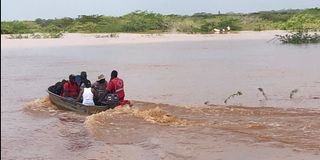Flood-prone residents must be safe and fed

A Kenya Red Cross official assists journalists to cross a flooded section of the Lamu-Garsen-Witu road in this photo taken on December 3, 2023.
The country has been experiencing downpours in most places during the El Nino rains which disrupted the lives of over 500,000 Kenyans through displacement, loss of life and limb and destruction of property.
In some places, especially the northern and coastal regions, it was a devastating experience as floods caused havoc, just as the weatherman had predicted.
Despite reports of the negative effects of the rains in some regions, the western and central Kenya, as well as the North Rift, received moderate rainfall, which was a major boost to the farming community. There has been adequate supply of food.
Fear of prolonged drought will cause fear among the pastoral communities and the other Kenyans who depend on rain-fed agriculture to supplement the decreased supply of fresh vegetables. This is because the rain has since reduced in many areas.
Soon, we will be back to the media stories about Kenyans ravaged by hunger, malnourished children and families that rely on well-wishers’ donations due to drought-induced famine. Ironically, such cases are common in most of the counties that recently experienced heavy downpours with large amounts of rainwater flowing to waste.
We only heard about the tragic incidents of ravaging floods having killed people and animals and destroyed property. There was none about the rainwater being harvested properly for agricultural and domestic use. During the prolonged drought that is synonymous with the perennially affected regions, the residents experience a myriad challenges. It is, therefore, important to have strong strategies and measures that focus on boosting agriculture in semi-arid areas for posterity.
Let the government initiate long-term projects that ensure heavy rains become a blessing, not a curse, to the people. Large dams could have helped in draining the water to minimise the destruction of floods. The water so harvested could be used for agricultural purposes, helping to boost economic activities and thus support livelihoods.
Make drought-prone areas very productive by initiating agricultural activities such as irrigation. Agriculture would also bring peace among communities with education prioritised and people’s dignity maintained by empowering them with better sources of livelihood to end donor dependency.
Agriculture would boost arid and semi-arid counties’ revenues, raising their ability to contribute to national development. With enough water for people and livestock, pastoralist communities can also engage in dairy farming and other lucrative activities. Children will go to school instead of herding livestock and women won’t go to fetch water.
ASAL county governments should champion construction of dams and seek other stakeholders’ support to enhance irrigation for a better future. The others should ensure rainwater is harvested, dams desalinated and water distributed to homes for domestic and farm use. That will make the residents self-reliant through agricultural projects.
- Mr Chitwa is communications officer, Uasin Gishu County government. [email protected].





